Vascular Endothelial Growth Factors (VEGF) Inhibitors Market Size
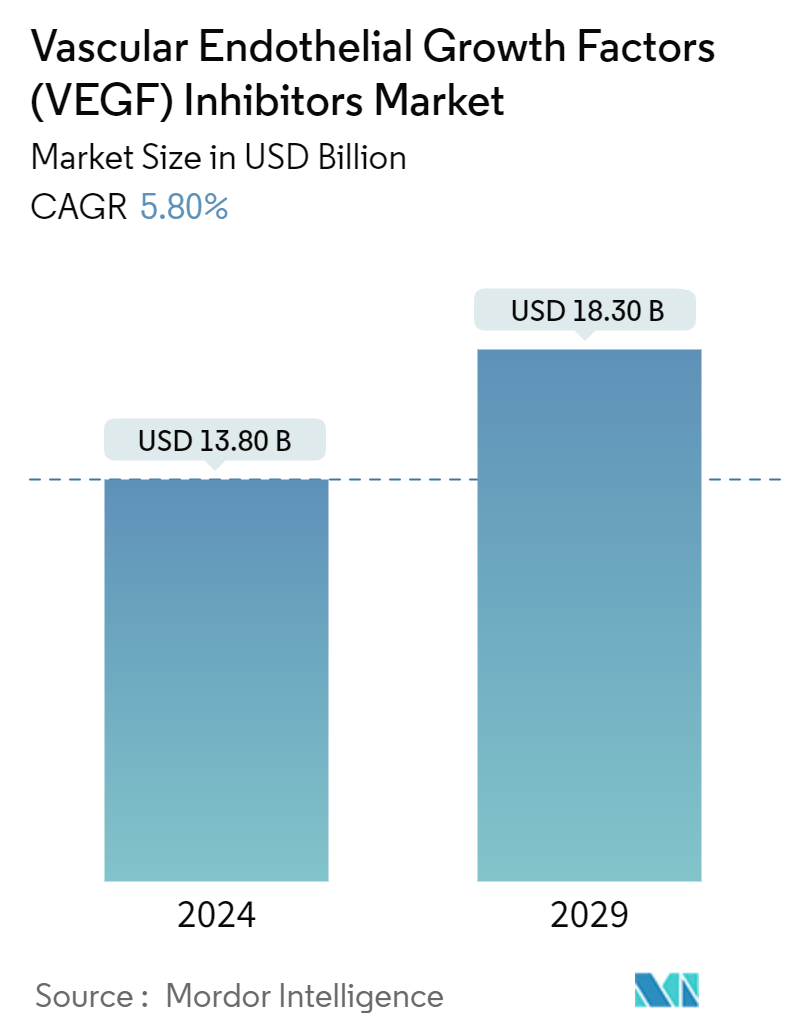
| Study Period | 2019 - 2029 |
| Market Size (2024) | USD 13.80 Billion |
| Market Size (2029) | USD 18.30 Billion |
| CAGR (2024 - 2029) | 5.80 % |
| Fastest Growing Market | Asia Pacific |
| Largest Market | North America |
Major Players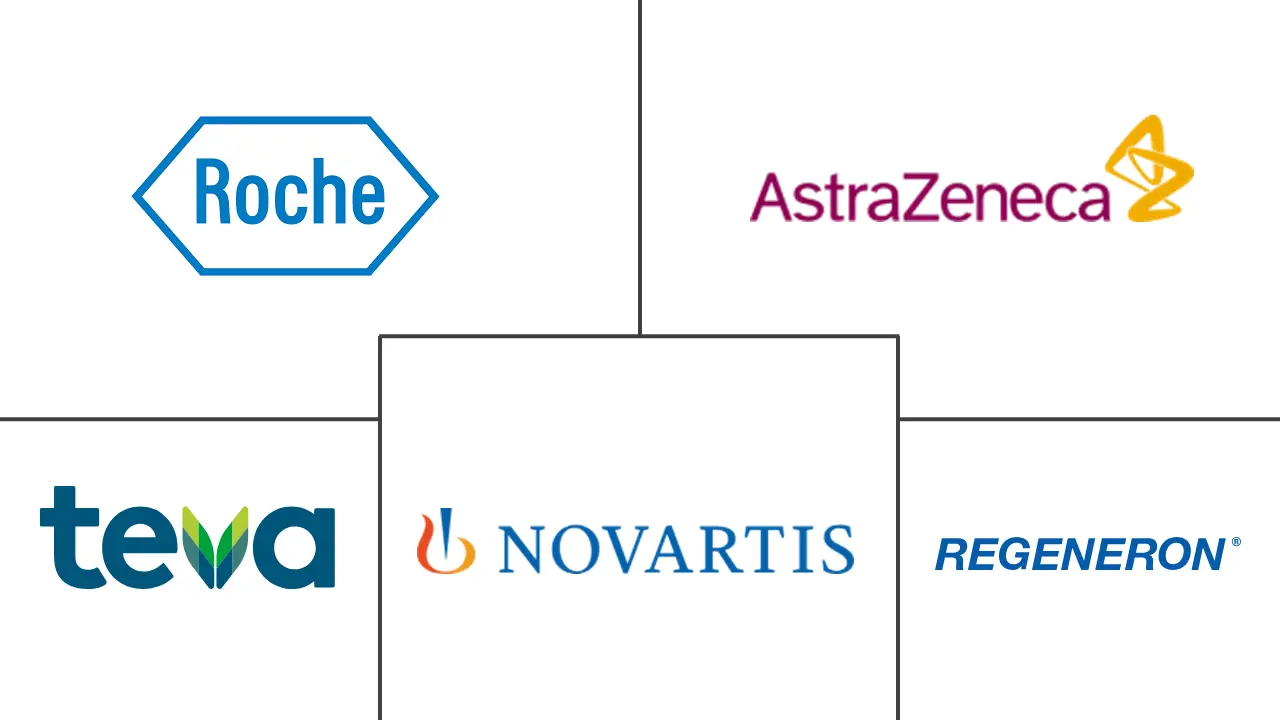
*Disclaimer: Major Players sorted in no particular order |
Vascular Endothelial Growth Factors (VEGF) Inhibitors Market Analysis
The Vascular Endothelial Growth Factors Inhibitors Market size is estimated at USD 13.80 billion in 2024, and is expected to reach USD 18.30 billion by 2029, growing at a CAGR of 5.80% during the forecast period (2024-2029).
Vascular endothelial growth factor (VEGF) inhibitors hinder the activity of VEGF and its receptors (VEGFR). These molecules are vital in forming new blood vessels, also known as angiogenesis. Vascular endothelial growth factor (VEGF) inhibitor drugs reduce blood vessel leakage and stop the growth of abnormal blood vessels. This abnormal blood vessel growth in the eye leads to low vision or blindness and damages the eye. Vascular endothelial growth factor (VEGF) inhibitors or anti-vascular endothelial growth factor (VEGF) drugs block VEGF to hinder the growth of blood vessels and improve the eye’s vision.
According to a study published in the Cureus Journal in September 2022, age-related macular degeneration (AMD) affects about one in eight persons aged 60 years and above in developed countries. It is estimated to affect 200 million people around the world. Although most AMD cases occur in Caucasians, African Americans and Asians are more likely to develop AMD. Furthermore, the study shows that the prevalence of AMD is expected to rise to almost 300 million people worldwide by 2040. Age-related macular degeneration (AMD) is caused by abnormal blood vessels forming under the macula in the eye. These abnormal blood vessels leak fluid, which disrupts the typical structure of the retina and causes the macula to become damaged. Early indications of age-related macular degeneration (AMD) are distorted vision (metamorphosis) and difficulty seeing things.
The growing prevalence of age-related macular degeneration (AMD) and the effectiveness of anti-vascular endothelial growth factor (VEGF) drugs as a treatment option all contribute to the growth of the vascular endothelial growth factor (VEGF) inhibitors market. This large and growing patient base creates significant demand for anti-vascular endothelial growth factor (VEGF) treatment to manage the disease. Therefore, this drives the market as patients seek effective treatments to preserve their sight.
However, the adverse effects associated with the utilization of VEGF inhibitors and preference for gene therapy will restrain market growth.
Vascular Endothelial Growth Factors (VEGF) Inhibitors Market Trends
The Oncology Segment is Expected to Witness Significant Growth Over the Forecast Period
The oncology application segment dominates the vascular endothelial growth factors (VEGF) inhibitor market and is expected to grow in the next five years.
According to the World Health Organization (WHO), in 2022, the global cancer burden was estimated to be 20 million new cases with 9.7 million deaths. Approximately 1 in 5 individuals develop cancer during their lifetime; about 1 in 9 males and about 1 in 12 females die from cancer. The projected number of new cancer cases in 2050 is projected to be over 35 million, which is an increase of 77% from the estimated number of 20 million in 2022. This rapidly increasing global cancer burden is a result of the aging and growth of the population, combined with changes in the exposure of people to risk factors.
This large number of patients means a growing need for effective treatment options. VEGF plays a vital role in the growth and spread of tumors. Cancer cells hijack the signaling of VEGFs to form new blood vessels. These new blood vessels provide oxygen and nutrients to the cancer cells, allowing them to grow and spread rapidly. Inhibitors of vascular endothelial growth factors (VEGFs) disrupt this process and starve the tumors of nutrients, slowing their growth and progression.
A study published in the Journal of Hematology & Oncology (2022) shows a well-established track record of success with vascular endothelial growth factors (VEGF) inhibitors in various cancers. For instance, drugs such as Avastin, a vascular endothelial growth factors (VEGF)-targeted drug, are effective in the treatment of lung cancer, colon cancer, and other types of cancer. These drugs have solidified their place as the cornerstone of cancer treatment. Hence, the growing prevalence of cancer is expected to drive the vascular endothelial growth factors (VEGF) inhibitors market.
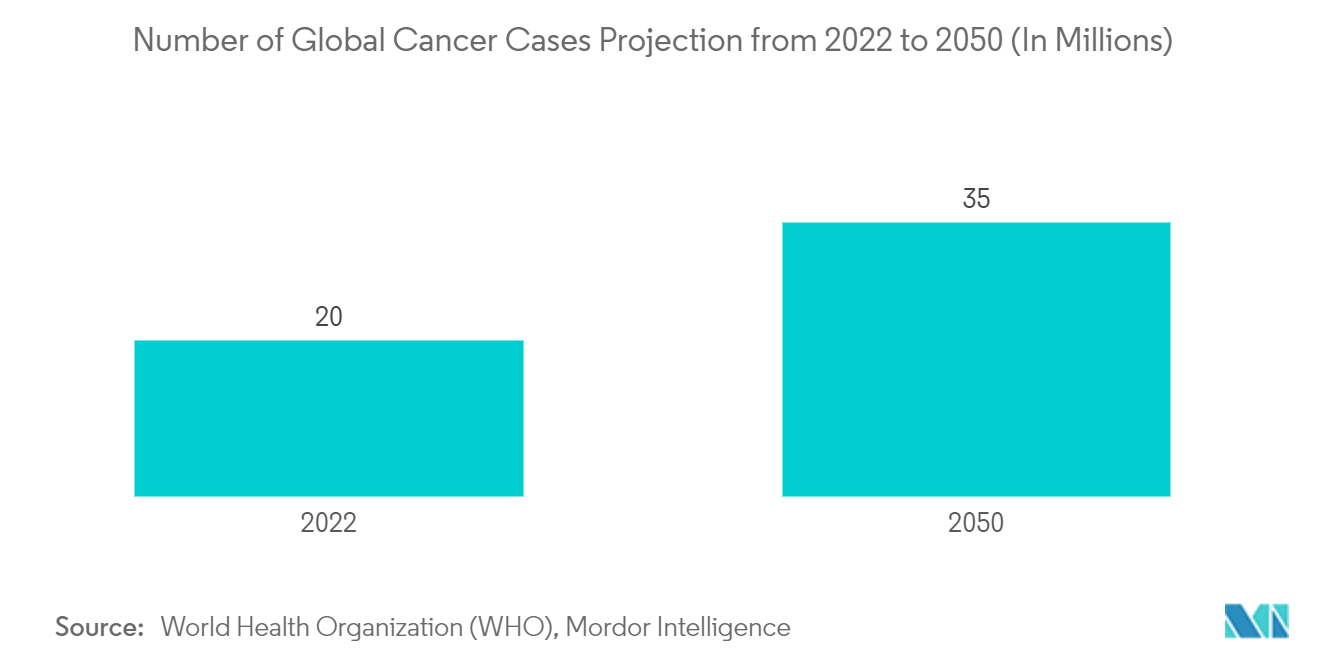
North America is Expected to Dominate the Vascular Endothelial Growth Factors (VEGF) Inhibitors Market
North America's leading in the vascular endothelial growth factors (VEGF) inhibitors market is mostly due to the higher prevalence of age-related macular degeneration (AMD), rapidly growing aging population, and clinical pipeline advancements that will drive the growth of the market in the region.
North America has a high prevalence of age-related macular degeneration AMD, with wet age-related macular degeneration (wet-AMD) being the leading cause of severe vision loss in older adults. This large number of patients requires effective treatments such as VEGF inhibitors. Age-related macular degeneration (AMD) is a disease associated with aging, and North America’s aging population contributes to its increase. As the population ages, the number of cases of AMD is expected to continue to rise.
According to Macular Degeneration Research in February 2023, macular degeneration is one of the leading causes of irreversible blindness and vision impairment. In the United States, approximately 20 million adults live with some form of AMD, with 1.5 million living with the advanced form. According to a new study published in the National Eye Institute (2023), the number of people living with AMD is expected to more than double between 2010 and 2050, rising from 2.1 million to 5.4 million. Moreover, advances in diagnostic techniques make it possible for AMD to be diagnosed earlier. Early diagnosis allows for prompt treatment with anti-VEGF inhibitors, which help to prevent vision loss.
The demand for anti-VEGF inhibitors is surging in Canada. A higher incidence of age-related macular degeneration, potentially expanding the demand for the treatment. According to a study published in Investigative Ophthalmology & Visual Science in June 2022, about 2.5% of Canadians suffer from age-related macular degeneration (AMD).
In conclusion, the confluence of an aging population, increasing prevalence of age-related macular degeneration (AMD), rising healthcare spending, growing disease awareness, and a robust development pipeline all contribute to the surging demand for vascular endothelial growth factors (VEGF) inhibitors in North America.
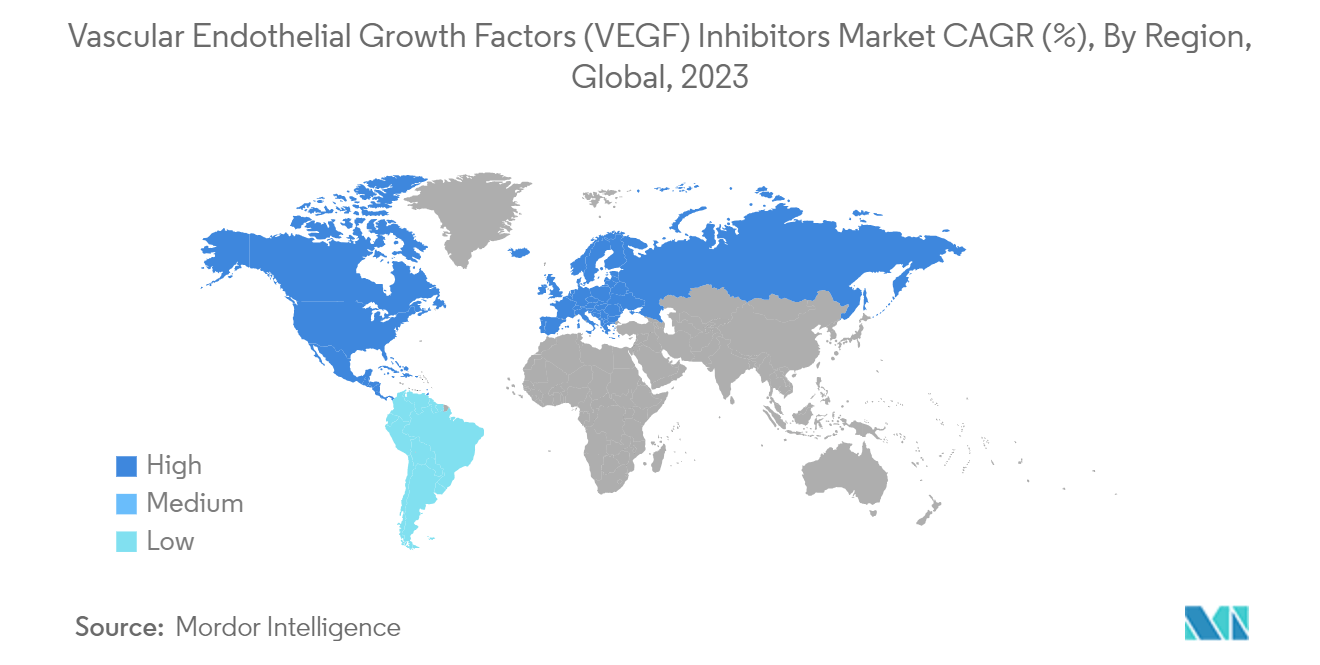
Vascular Endothelial Growth Factors (VEGF) Inhibitors Industry Overview
The market for VEGF inhibitors is highly competitive, with established and new entrants competing for market share, innovation, patent expirations, and unmet needs, which are key drivers shaping the future of this market. The major players in the market include F. Hoffmann-La Roche Ltd, AstraZeneca, Teva Pharmaceutical Industries Ltd, F. Hoffmann-La Roche Ltd, Regeneron Pharmaceuticals In, Bayer AG, Novartis AG, Merck KGaA, Pfizer Inc., Xbrane Biopharma AB, among others.
Vascular Endothelial Growth Factors (VEGF) Inhibitors Market Leaders
-
F. Hoffmann-La Roche Ltd
-
Astrazeneca
-
Regeneron Pharmaceuticals Inc.
-
Novartis AG
-
Xbrane Biopharma AB
*Disclaimer: Major Players sorted in no particular order
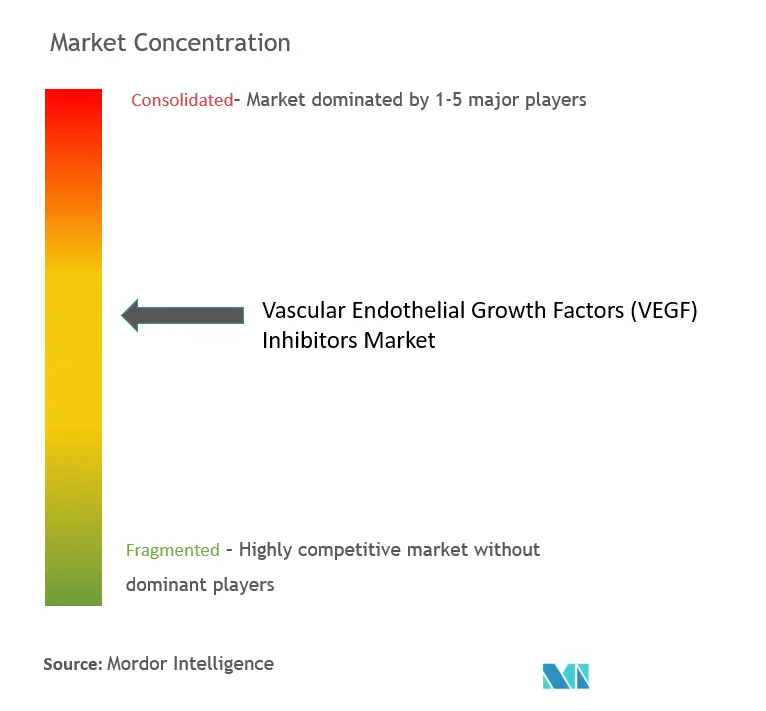
Vascular Endothelial Growth Factors (VEGF) Inhibitors Market News
- In August 2023, Regeneron Pharmaceuticals secured FDA approval for EYLEA HD (aflibercept) Injection 8mg. The treatment targets wet age-related macular degeneration (wAMD), diabetic macular edema (DME), and diabetic retinopathy (DR). EYLEA HD offers the potential benefit of extended dosing intervals compared to standard EYLEA after the initial treatment phase.
- In May 2023, STADA and Xbrane collaborated and launched Ximluci®, the first ranibizumab biosimilar in Germany. Ximluci targets neovascular diseases of the retina (nAMD, DME, PDR, RVO, and CNV). This launch expanded STADA's biosimilar portfolio to six products and offered a new treatment option for ophthalmologists in Germany.
- In August 2022, Teva Pharmaceutical Industries Ltd announced that the European Commission (EC) had granted a Marketing Authorization for Ranivisio (ranibizumab), a biosimilar of the ophthalmology treatment Lucentis across all five indications in adults for which Lucentisis authorized.
Vascular Endothelial Growth Factors (VEGF) Inhibitors Market Report - Table of Contents
1. INTRODUCTION
- 1.1 Study Assumptions and Market Definition
- 1.2 Scope of the Study
2. RESEARCH METHODOLOGY
3. EXECUTIVE SUMMARY
4. MARKET DYNAMICS
- 4.1 Market Overview
-
4.2 Market Drivers
- 4.2.1 Advancements in Clinical Pipeline Analysis
- 4.2.2 Rising Prevalence of Age-Related Macular Degeneration
- 4.2.3 Growing Popularity of Combination Therapies
-
4.3 Market Restraints
- 4.3.1 Rising Preference for Gene Therapy
-
4.4 Porter's Five Force Analysis
- 4.4.1 Threat of New Entrants
- 4.4.2 Bargaining Power of Buyers/Consumers
- 4.4.3 Bargaining Power of Suppliers
- 4.4.4 Threat of Substitute Products
- 4.4.5 Intensity of Competitive Rivalry
5. MARKET SEGMENTATION (Market Size by Value - USD)
-
5.1 By Type
- 5.1.1 VEGF-A
- 5.1.2 VEGF-B
- 5.1.3 VEGF-C
- 5.1.4 VEGF-D
-
5.2 By Application
- 5.2.1 Oncology
- 5.2.2 Ophthalmology
- 5.2.3 Other Applications
-
5.3 By Route of Administration
- 5.3.1 Intravenous
- 5.3.2 Oral
-
5.4 By End User
- 5.4.1 Hospitals
- 5.4.2 Specialty Clinics
- 5.4.3 Other End Users
-
5.5 Geography
- 5.5.1 North America
- 5.5.1.1 United States
- 5.5.1.2 Canada
- 5.5.1.3 Mexico
- 5.5.2 Europe
- 5.5.2.1 Germany
- 5.5.2.2 United Kingdom
- 5.5.2.3 France
- 5.5.2.4 Italy
- 5.5.2.5 Spain
- 5.5.2.6 Rest of Europe
- 5.5.3 Asia-Pacific
- 5.5.3.1 China
- 5.5.3.2 Japan
- 5.5.3.3 India
- 5.5.3.4 Australia
- 5.5.3.5 South Korea
- 5.5.3.6 Rest of Asia-Pacific
- 5.5.4 Middle East and Africa
- 5.5.4.1 GCC
- 5.5.4.2 South Africa
- 5.5.4.3 Rest of Middle East and Africa
- 5.5.5 South America
- 5.5.5.1 Brazil
- 5.5.5.2 Argentina
- 5.5.5.3 Rest of South America
6. COMPETITIVE LANDSCAPE
-
6.1 Company Profiles
- 6.1.1 F. Hoffmann-La Roche Ltd
- 6.1.2 Astrazeneca
- 6.1.3 Teva Pharmaceutical Industries Ltd
- 6.1.4 F. Hoffmann-La Roche Ltd
- 6.1.5 Regeneron Pharmaceuticals Inc.
- 6.1.6 Bayer AG
- 6.1.7 Novartis AG
- 6.1.8 Merck KGaA
- 6.1.9 Pfizer Inc.
- 6.1.10 Xbrane Biopharma AB
- *List Not Exhaustive
7. MARKET OPPORTUNITIES AND FUTURE TRENDS
** Subject To AvailablityVascular Endothelial Growth Factors (VEGF) Inhibitors Industry Segmentation
The vascular endothelial growth factor inhibitors are substances that inhibit VEGF/VEGFR activity. The vascular endothelial growth factor receptor (VEGFR) signaling modulates angiogenesis. Angiogenesis is the process of making new blood vessels by removing existing blood vessels.
The vascular endothelial growth factors (VEGF) inhibitors market is segmented into type, application, route of administration, end user, and geography. By type, the market is VEGF-A, VEGF-B, VEGF-C, and VEGF-D. By treatment, oncology, ophthalmology, and others (arthritis, cardiovascular diseases, etc.). By route of administration, intravenous and oral. By end user, hospitals, specialty clinics, and others (ambulatory surgical centers, home care settings, etc.). By geography, the market is segmented into North America, Europe, Asia-Pacific, South America, and Middle East and Africa. The report also offers the market size and forecasts for 17 countries across the region. For each segment, the market sizing and forecasts were made on the basis of value (USD).
| By Type | VEGF-A | |
| VEGF-B | ||
| VEGF-C | ||
| VEGF-D | ||
| By Application | Oncology | |
| Ophthalmology | ||
| Other Applications | ||
| By Route of Administration | Intravenous | |
| Oral | ||
| By End User | Hospitals | |
| Specialty Clinics | ||
| Other End Users | ||
| Geography | North America | United States |
| Canada | ||
| Mexico | ||
| Geography | Europe | Germany |
| United Kingdom | ||
| France | ||
| Italy | ||
| Spain | ||
| Rest of Europe | ||
| Geography | Asia-Pacific | China |
| Japan | ||
| India | ||
| Australia | ||
| South Korea | ||
| Rest of Asia-Pacific | ||
| Geography | Middle East and Africa | GCC |
| South Africa | ||
| Rest of Middle East and Africa | ||
| Geography | South America | Brazil |
| Argentina | ||
| Rest of South America |
Vascular Endothelial Growth Factors (VEGF) Inhibitors Market Research FAQs
How big is the Vascular Endothelial Growth Factors Inhibitors Market?
The Vascular Endothelial Growth Factors Inhibitors Market size is expected to reach USD 13.80 billion in 2024 and grow at a CAGR of 5.80% to reach USD 18.30 billion by 2029.
What is the current Vascular Endothelial Growth Factors Inhibitors Market size?
In 2024, the Vascular Endothelial Growth Factors Inhibitors Market size is expected to reach USD 13.80 billion.
Who are the key players in Vascular Endothelial Growth Factors Inhibitors Market?
F. Hoffmann-La Roche Ltd, Astrazeneca, Regeneron Pharmaceuticals Inc., Novartis AG and Xbrane Biopharma AB are the major companies operating in the Vascular Endothelial Growth Factors Inhibitors Market.
Which is the fastest growing region in Vascular Endothelial Growth Factors Inhibitors Market?
Asia Pacific is estimated to grow at the highest CAGR over the forecast period (2024-2029).
Which region has the biggest share in Vascular Endothelial Growth Factors Inhibitors Market?
In 2024, the North America accounts for the largest market share in Vascular Endothelial Growth Factors Inhibitors Market.
What years does this Vascular Endothelial Growth Factors Inhibitors Market cover, and what was the market size in 2023?
In 2023, the Vascular Endothelial Growth Factors Inhibitors Market size was estimated at USD 13.00 billion. The report covers the Vascular Endothelial Growth Factors Inhibitors Market historical market size for years: 2019, 2020, 2021, 2022 and 2023. The report also forecasts the Vascular Endothelial Growth Factors Inhibitors Market size for years: 2024, 2025, 2026, 2027, 2028 and 2029.
Vascular Endothelial Growth Factors (VEGF) Inhibitors Industry Report
Statistics for the 2024 Vascular Endothelial Growth Factors (VEGF) Inhibitors market share, size and revenue growth rate, created by Mordor Intelligence™ Industry Reports. Vascular Endothelial Growth Factors (VEGF) Inhibitors analysis includes a market forecast outlook for 2024 to 2029 and historical overview. Get a sample of this industry analysis as a free report PDF download.



